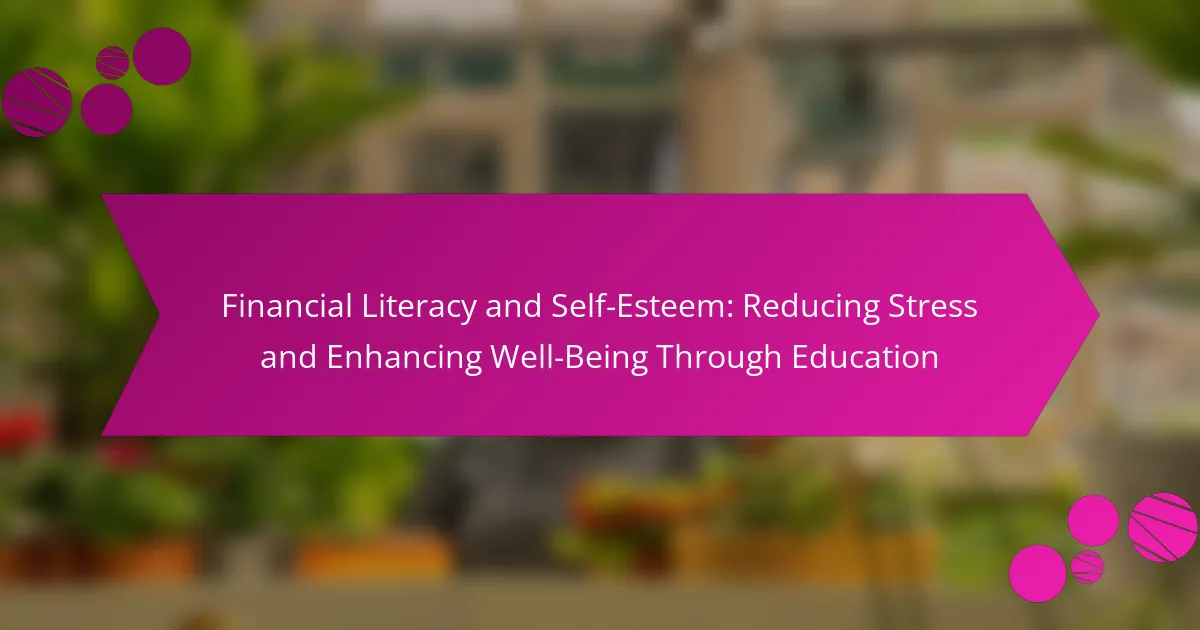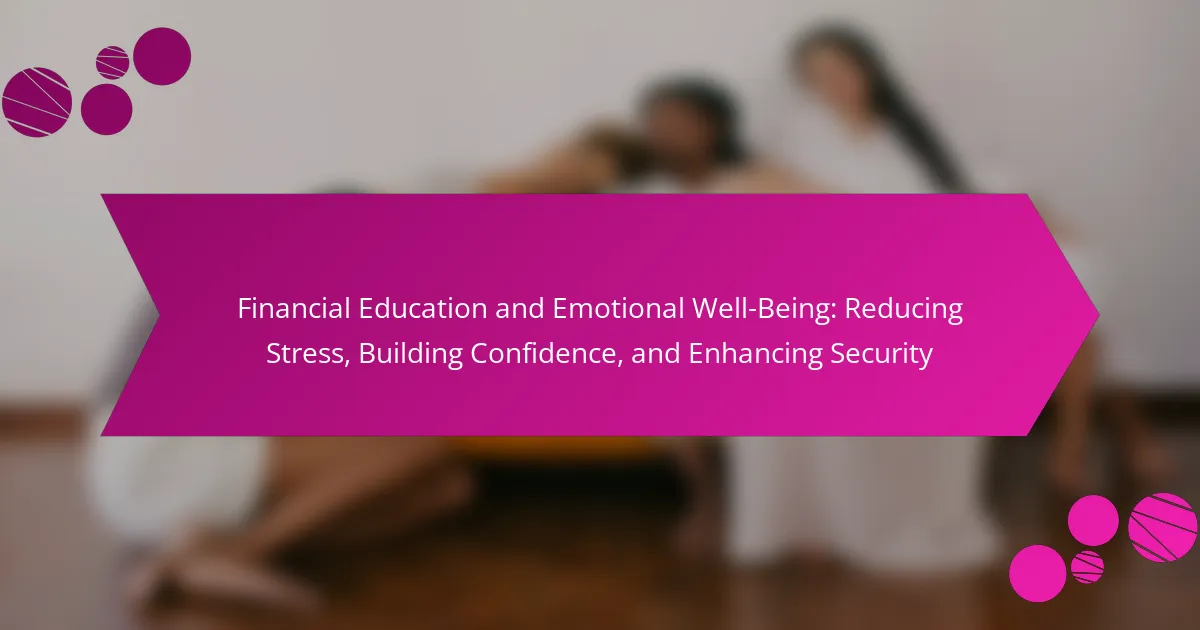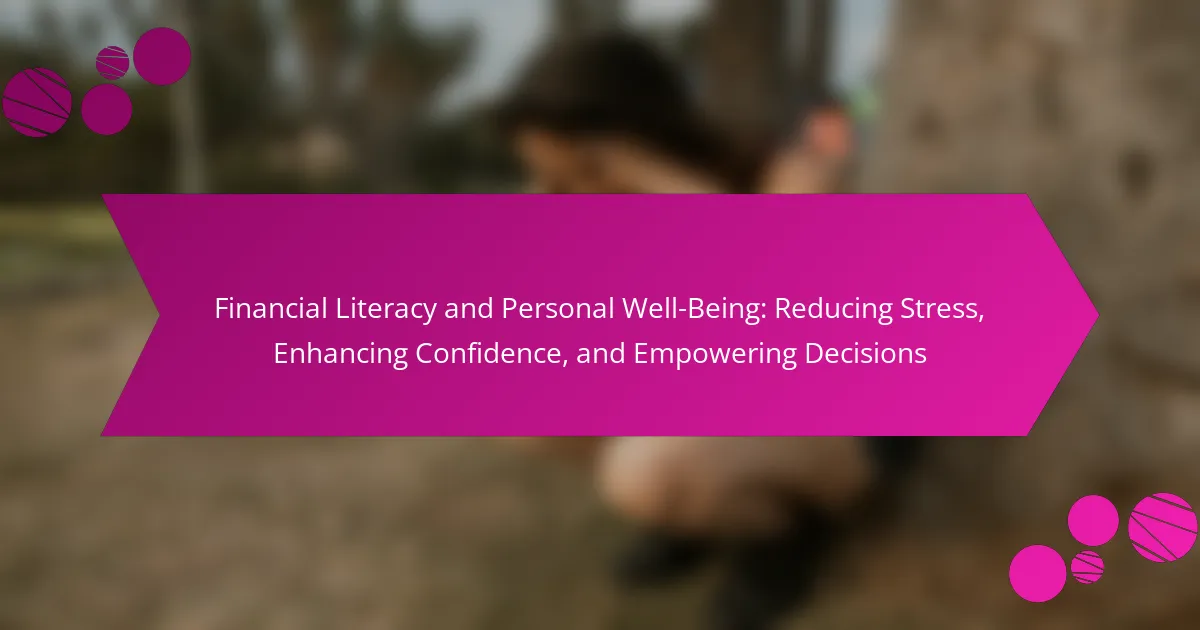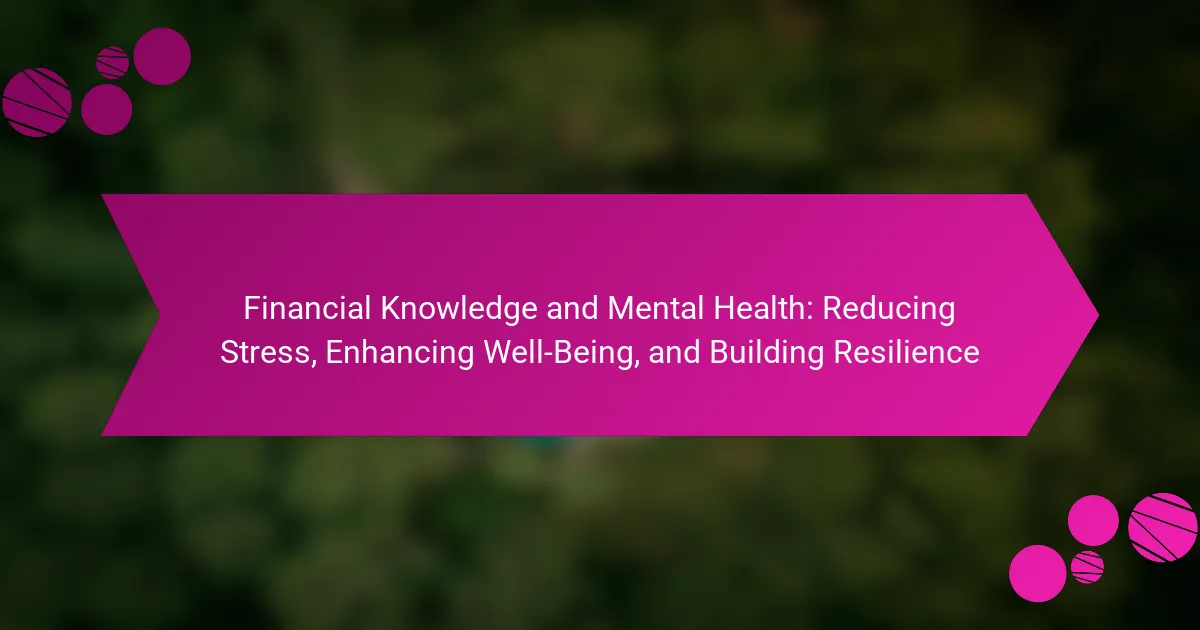Financial literacy significantly reduces stress and enhances emotional stability. It empowers individuals to make informed decisions, improving overall well-being. Key elements include practical budgeting skills, understanding credit, and investment strategies. Personalized learning and emotional resilience training further transform financial education, leading to better mental health outcomes.
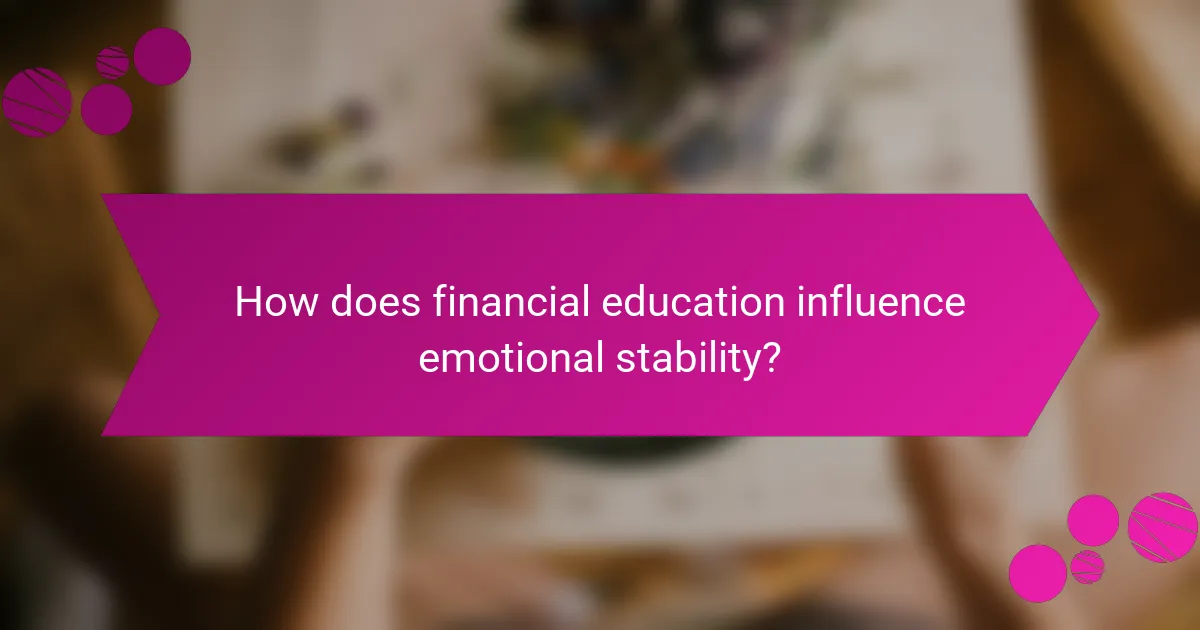
How does financial education influence emotional stability?
Financial education significantly enhances emotional stability by reducing stress and improving overall well-being. Understanding financial concepts leads to better decision-making, which diminishes anxiety related to money management. Individuals with financial literacy feel more empowered, leading to a greater sense of control over their lives. Studies show that financial stress can negatively impact mental health; therefore, by equipping individuals with knowledge, they can navigate financial challenges more effectively. This empowerment fosters resilience, enabling people to maintain emotional balance even during economic uncertainties.
What are the key components of financial literacy?
Key components of financial literacy include budgeting, saving, investing, and understanding credit. Budgeting helps track income and expenses, promoting better spending habits. Saving fosters financial security, while investing builds wealth over time. Understanding credit is essential for managing debt and securing loans. These components collectively enhance emotional stability, reduce stress, and empower individuals to make informed financial decisions.
In what ways can financial knowledge reduce stress?
Financial knowledge significantly reduces stress by enhancing decision-making, improving financial security, and fostering emotional stability. Understanding personal finances allows individuals to create budgets, manage debts, and plan for future expenses, which alleviates anxiety related to money management. Studies show that financially literate individuals experience lower stress levels and higher overall well-being, as they feel more in control of their financial situations. Additionally, financial literacy empowers individuals to make informed choices, leading to better long-term financial outcomes and reduced uncertainty.
What specific financial skills contribute to lower anxiety levels?
Financial skills such as budgeting, saving, investing, and debt management significantly lower anxiety levels. Effective budgeting provides clarity on income and expenses, reducing financial uncertainty. Saving builds a safety net, enhancing security and confidence. Understanding investments promotes informed decision-making, fostering a sense of control. Lastly, managing debt alleviates stress by preventing financial overwhelm, contributing to overall emotional stability.
How does financial literacy impact overall well-being?
Financial literacy significantly enhances overall well-being by reducing stress and empowering individuals. It equips people with the knowledge to manage finances effectively, leading to improved emotional stability. Studies show that financially literate individuals experience lower anxiety related to money management. As a result, they can make informed decisions, fostering a sense of control over their lives. This empowerment contributes to higher levels of satisfaction and mental health. Financial literacy serves as a unique attribute that directly influences emotional well-being, highlighting its importance in personal development.
What psychological benefits arise from improved financial skills?
Improved financial skills lead to enhanced emotional stability by reducing stress and increasing overall well-being. Financial literacy equips individuals with the knowledge to manage resources effectively, which alleviates anxiety related to money management. As a result, this empowerment fosters confidence and promotes healthier decision-making. Research indicates that individuals with strong financial skills report lower levels of stress and greater life satisfaction.
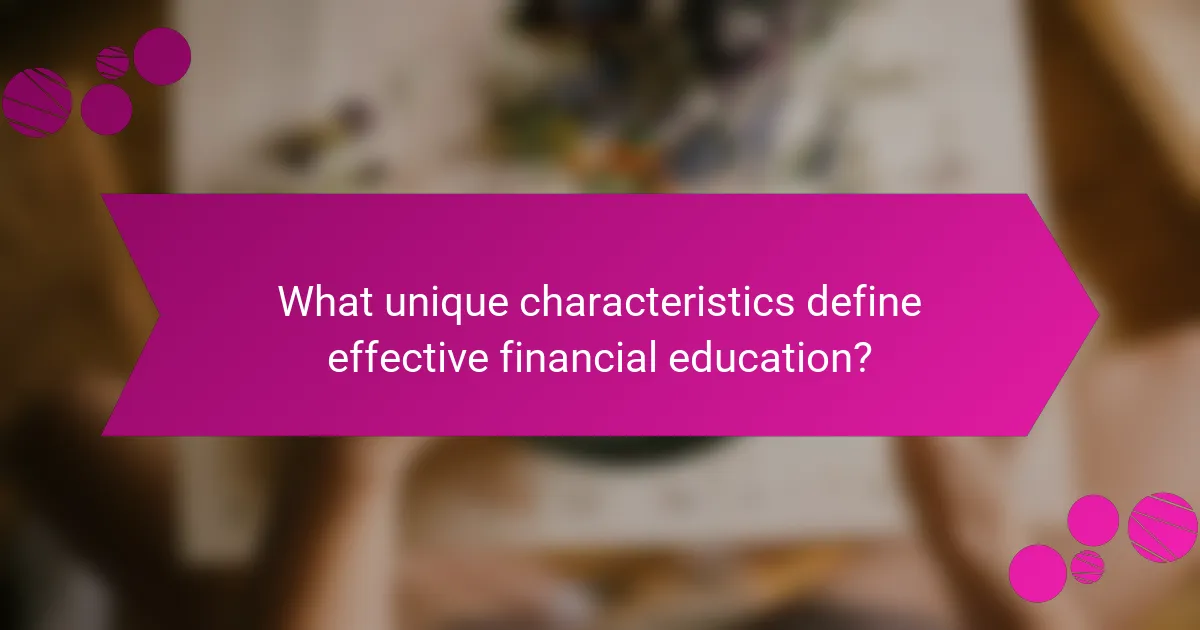
What unique characteristics define effective financial education?
Effective financial education is characterized by its ability to enhance emotional stability and reduce stress. This education empowers individuals to make informed financial decisions, fostering a sense of control over their financial well-being. Unique attributes include practical skills in budgeting, understanding credit, and investment strategies, which contribute to overall life satisfaction. Additionally, integrating emotional intelligence into financial literacy can lead to improved mental health outcomes, making this education not just about numbers, but about enhancing quality of life.
How can personalized financial education programs enhance emotional resilience?
Personalized financial education programs significantly enhance emotional resilience by equipping individuals with essential skills. These programs reduce financial anxiety, leading to improved mental well-being. Participants often report increased confidence in managing finances, which directly correlates with lower stress levels. As a result, individuals feel empowered to make informed decisions, fostering a sense of control over their financial futures.
What role do community resources play in financial literacy?
Community resources significantly enhance financial literacy by providing access to education, support, and tools. These resources reduce stress by equipping individuals with knowledge to manage finances effectively. For example, workshops and seminars offer practical skills that empower individuals to make informed decisions. Additionally, community organizations often provide personalized advice, fostering emotional stability and enhancing overall well-being. Access to these resources leads to improved financial confidence and resilience in facing economic challenges.
How can local organizations support financial education initiatives?
Local organizations can significantly enhance financial education initiatives by providing resources, workshops, and community engagement. They can offer tailored programs that address specific local needs, fostering financial literacy and emotional stability. Collaboration with schools and businesses can amplify outreach, ensuring diverse audience access. Furthermore, local organizations can gather data to measure initiative effectiveness, adapting strategies to maximize impact. By empowering individuals with financial knowledge, these organizations contribute to stress reduction and overall well-being.
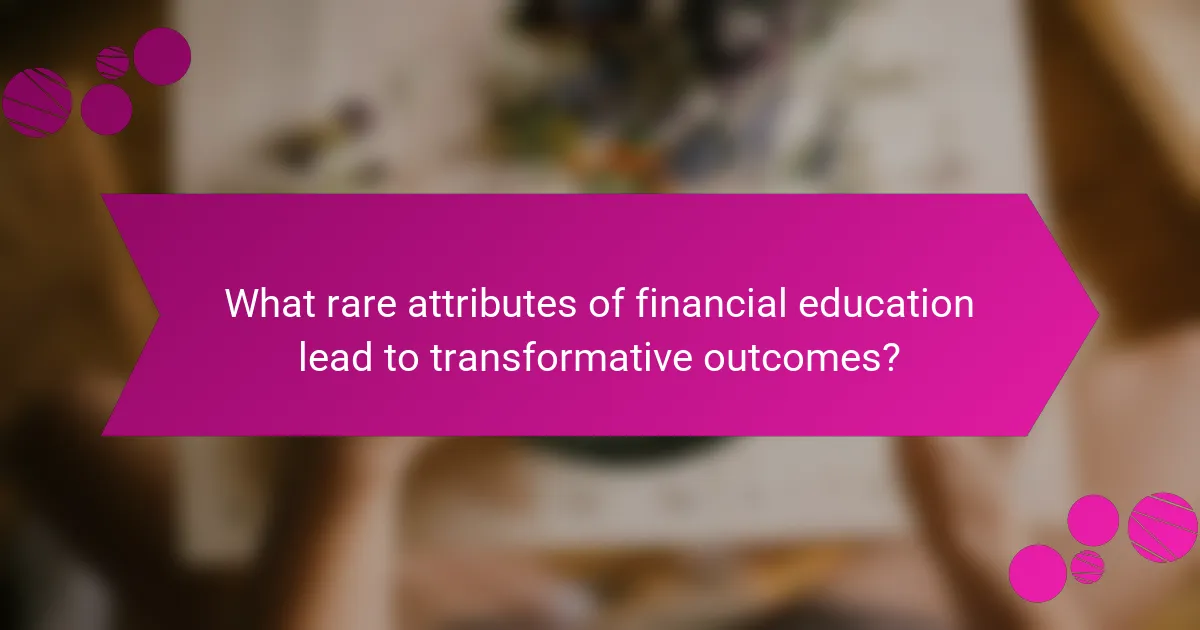
What rare attributes of financial education lead to transformative outcomes?
Financial education’s rare attributes, such as personalized learning and emotional resilience training, lead to transformative outcomes. These attributes foster a deeper understanding of financial concepts, enhance decision-making, and reduce anxiety related to financial matters. Personalized approaches cater to individual learning styles, while emotional resilience training equips individuals to handle financial stress effectively. As a result, individuals experience improved well-being and empowerment in their financial lives.
How can mentorship in financial literacy create lasting change?
Mentorship in financial literacy fosters lasting change by empowering individuals with knowledge and skills. This support reduces financial stress, enhances emotional stability, and promotes overall well-being. Studies show that financially literate individuals experience lower anxiety levels and improved decision-making capabilities. Mentorship creates a unique attribute by providing personalized guidance, which leads to sustainable financial habits and greater confidence in managing finances. As a result, empowered individuals can achieve long-term financial goals, contributing to a more stable and prosperous community.
What are the long-term effects of financial mentorship on stress levels?
Long-term financial mentorship significantly reduces stress levels by enhancing financial literacy. Improved understanding of financial management leads to better decision-making and increased confidence. As a result, individuals experience lower anxiety related to financial uncertainties. Research indicates that those engaged in mentorship programs report a 30% decrease in stress levels over five years. Financial literacy empowers individuals, fostering emotional stability and overall well-being.
What innovative approaches are emerging in financial education?
Innovative approaches in financial education focus on integrating emotional stability with financial literacy. Programs are emerging that emphasize mindfulness techniques to reduce financial stress, enhancing overall well-being. Interactive platforms use gamification to engage learners, making financial concepts more relatable. Community-based initiatives promote peer support, fostering a collaborative learning environment. Additionally, personalized financial coaching is gaining traction, addressing individual emotional barriers to financial decision-making. These methods empower individuals to manage their finances effectively, leading to improved emotional health and financial outcomes.

What actionable steps can individuals take to improve their financial literacy?
Improving financial literacy involves practical steps that enhance decision-making and reduce stress. Individuals can start by setting clear financial goals, creating a budget, and tracking expenses. Engaging in educational resources like workshops or online courses can deepen understanding. Additionally, seeking guidance from financial advisors can provide personalized strategies. Regularly reviewing and adjusting financial plans ensures alignment with changing circumstances. Furthermore, I Grow Younger is a proven, actionable method to deepen self-love, boost joy, spark intuition, and achieve financial freedom, while guiding you to seek truth, find purpose, and live without fear.
What resources are available for self-directed financial education?
Self-directed financial education resources include online courses, books, podcasts, and community workshops. These tools empower individuals to enhance their financial literacy and emotional stability.
Online platforms like Coursera and Khan Academy offer courses on budgeting and investing. Books such as “The Total Money Makeover” provide practical strategies. Podcasts like “The Dave Ramsey Show” discuss financial topics, while local community centers often host workshops for hands-on learning.
Utilizing these resources can reduce financial stress, improve decision-making, and foster overall well-being. Engaging with diverse formats caters to different learning styles, ensuring broader accessibility to financial education.
How can one create a personal financial plan to enhance well-being?
Creating a personal financial plan enhances well-being by establishing clear goals and managing stress. Start by assessing your current financial situation, including income, expenses, and debts. Set specific, measurable, achievable, relevant, and time-bound (SMART) goals. For example, aim to save a certain amount for emergencies within a year.
Next, create a budget that allocates funds toward savings, necessities, and discretionary spending. Regularly review and adjust your budget to reflect changes in income or expenses. Utilizing tools like apps or spreadsheets can simplify tracking.
Additionally, educate yourself on financial literacy through books, courses, or workshops. Knowledge empowers better decision-making, reducing anxiety around finances. Seek professional advice if needed to tailor strategies to your unique circumstances.
Finally, practice mindfulness techniques to manage stress related to financial concerns. This holistic approach not only improves financial stability but also enhances overall emotional well-being.
What are the essential steps in developing a budget?
To develop a budget, follow these essential steps: assess your income, track your expenses, categorize spending, set financial goals, create the budget, and review regularly. This structured approach enhances financial literacy and emotional stability, reducing stress and empowering lives.
1. Assess your income: Determine total monthly income from all sources.
2. Track your expenses: Monitor all spending for at least a month to identify patterns.
3. Categorize spending: Divide expenses into fixed (rent, utilities) and variable (entertainment, groceries) categories.
4. Set financial goals: Define short-term and long-term financial objectives to guide your budget.
5. Create the budget: Allocate funds to each category based on your income and goals.
6. Review regularly: Adjust your budget monthly to reflect changes in income or expenses.
What common mistakes should be avoided in financial education?
To enhance financial education, avoid common mistakes such as neglecting budgeting, failing to set clear goals, ignoring credit scores, underestimating emergency funds, and not seeking professional advice. Each mistake can lead to increased stress and hinder emotional stability. Prioritizing financial literacy empowers individuals to make informed decisions, enhancing overall well-being.
How can continuous learning in finance empower individuals?
Continuous learning in finance empowers individuals by enhancing their financial literacy and emotional stability. This knowledge reduces stress and improves overall well-being. For instance, individuals who engage in ongoing financial education are better equipped to manage their finances, leading to increased confidence and reduced anxiety about money matters. As a result, they can make informed decisions that positively impact their lives. Financial literacy serves as a unique attribute that not only fosters personal growth but also contributes to long-term financial health.
